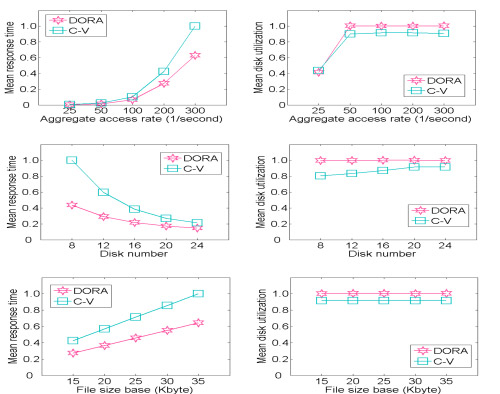Xiao Qin's Research
Final Report
BUD: A Buffer-Disk Architecture for Energy Conservation in Parallel Disk Systems
Download BUD Annual Report PDF
Findings
An Energy-Efficient Framework for Large-Scale Parallel Storage Systems
A Simulation Framework for Energy-efficient Data Grids
An Energy-Efficient Scheduling Algorithm Using Dynamic Voltage Scaling
for Parallel Applications on Clusters
Load-Balancing Strategies for Energy-Efficient Parallel Storage Systems with Buffer Disks
Sacrificing Reliability for Energy Saving: Is It Worthwhile for Disk Arrays
Load-Balancing Strategies for Energy-Efficient Parallel Storage Systems with Buffer Disks
Energy-Efficient Prefetching for Parallel I/O Systems with Buffer Disks
Improving Reliability and Energy Efficiency of Disk Systems via Utilization Control
Energy Conservation for Real-Time Disk Systems with I/O Burstiness
An Adaptive Energy-Conserving Strategy for Parallel Disk Systems
DARAW: A New Write Buffer to Improve Parallel I/O Energy-Efficiency
MICRO: A Multi-level Caching-based Reconstruction Optimization for Mobile Storage Systems
PEARL: Performance, Energy, and Reliability Balanced Dynamic Data Redistribution for Next Generation Disk Arrays
HyBUD: An Energy-Efficient Architecture for Hybrid Parallel Disk Systems
Energy-Aware Prefetching for Parallel Disk Systems
DORA: A Dynamic File Assignment Strategy with Replication
Collaboration-Oriented Data Recovery for Mobile Disk Arrays
A File Assignment Strategy Independent of Workload Characteristic Assumptions
References
HyBUD: An Energy-Efficient Architecture for Hybrid Parallel Disk Systems [Nijim et al. 2009]
The figure below depicts a hybrid disk architecture or HYBUD containing a 2-GB flash drive, m buffer disks, n data disks, and an energy-aware flash drive/buffer disk controller. Note that the values of n and m, which are configuration on the fly, are independent of each other. A RAM buffer with a size ranging from several megabytes to gigabytes is incorporated to further improve I/O performance in HYBUD. The flash drive/buffer disk controller coordinates multiple modules, including power management, data partitioning, disk request processing, and perfecting schemes.
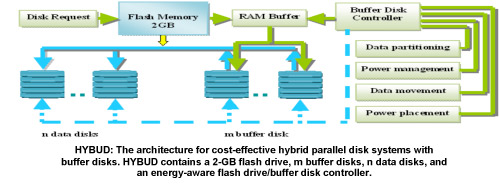
The 2-GB flash drive performs as a non-volatile data cache to boost I/O performance and improve energy efficiency by absorb disk traffic fluctuations. The flash drive respond to both read and write disk requests. A read miss in the flash drive causes a hit at one of the buffer disks. the block to be fetched from data disks and written into the flash memory. Write requests are served by the flash drive first. If the flash drive is full, write requests are redirected to buffer disks.
A prefetching scheme is designed to bring data into buffer disks or flash drives before its use. Apart from the prefetching scheme, we developed a write strategy to energy-efficiently handle writes using flash drive and buffer disks. The write I/O load imposed on buffer disks is well balanced by equally distributed write request to all the active buffer disks to make the utilization of all the buffer disks identical.
To improve I/O performance of buffer disks handing write requests, we chose to use a log file system that allows data to be written sequentially buffered in buffer disks to minimize disk seek times and rotational delays. We developed a buffer disk manager that is responsible for the following activities. First, the disk manager aims to minimize the number of active buffer disks while maintaining reasonably quick response time for disk requests. Second, the manager must deal with the read and write requests redirected from the flash drive in an energy-efficient way. Third, the manager has to energy-efficiently move data among the flash drive, buffer disks, and data disks.
Our preliminary results consist of developing a simulator, which meets all projects specifications and implementing all the required functions that are necessary to model our distributed system. We compared our HYBUD strategy with two baseline strategies. The first strategy is called flash strategy where only the flash memory is used to serve the requests. The second strategy is BUD strategy where only the buffer disks are used to serve the disk requests. This experiment is focused on comparing the HYBUD strategy against the two other strategies described above. We study the impacts of miss ratio on the normalized energy consumption measured in joule. To achieve this goal, we increased the miss ratio of disk request from 75 to 100.

The above figure plots empirical results when there are five disks in a parallel I/O system and the average size of disk requests is 300 MB. As the miss rate is increased, the energy consumption of the three strategies also increased. The HYBUD strategy consumes less energy than the other two alternatives strategy. We will discuss each strategy separately. When the disk request is submitted to the flash memory and if there is a miss, then the total energy cost will be the energy cost of read and the energy cost of writing the request into the flash under the assumption that this request will be frequently used in the future, and the cost of keep waking up the corresponding data disk every time the read request is made which leads to a huge energy consumption. For the BUD strategy, it consumes less energy than using only the flash memory strategy. This can be explained by the fact that the BUD strategy when miss occurs, it clusters read requests together if the disk is in sleeping mode. As a result, it provides a long disk idle times.
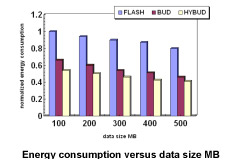
Finally the HYBUD strategy consumes the least energy. When the read request is submitted to the flash memory, they read request will be served immediately if the data disk is in active mode, otherwise, the read request will be written to the flash assuming that these requests will be frequently used. When the flash is full, the dirty data will be flushed to the buffer disks and all the miss requests will be clustered together, which leads to less energy consumption.
In this experiment we compared the three strategies in term of the size of data block. The above figure illustrates the impact of data size over the energy consumption for the three strategies. As the data size increases, the energy consumption for the three strategies decreases. This can be explained by the fact smaller data sizes decrease the time window in which a disk is able to sleep. In case of small data size, flash memory is no longer able to save energy, because the flash memory keep waking up the disk, which results in huge energy consumption. The HYBUD strategy can save up to 51% over the flash memory and 22% over BUD.
Energy-Aware Prefetching for Parallel Disk Systems [Manzanares et al. 2009]
For our experimental results we implemented a parallel disk simulator in JAVA. The first set of experiments we conducted varied the hit rate and the data size of the requests. The hit rate in these experiments is defined as the percentage of all the requests that can be served by the buffer disk and the data size is defined as the data size of each request. We generated random disk requests and varied the inter-arrival delay of the requests. The inter-arrival rate must be fairly low to produce energy savings or disks will never be placed in the sleep state. If the inter-arrival rate is high all disks must be active to serve the requests. The results of the first set of experiments are summarized in the Figure below.
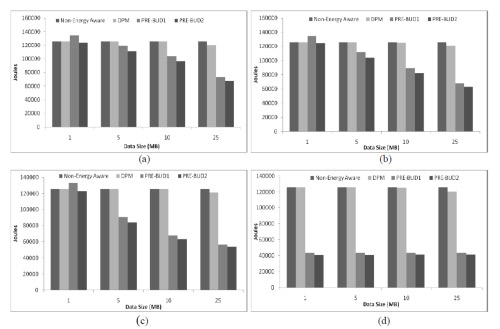
Total Energy Consumption of Disk System while Data Size is varied for four different values of hit rate: (a) 85 %, (b) 90 %, (c) 95 %, and (d) 100 % hit rate.
There are two main observations we can draw from this figure, one being that as data size increases energy savings increases, and second, as the hit rate is increased energy savings increases. As the data size increases the time to serve the request increases. If multiple requests can be served from the buffer disk than the data disks have a greater opportunity to transition to the sleep state. Similarly as the hit rate increases the buffer disk serves a greater number of consecutive hits allowing data disks to sit idle for longer periods of time. The goal of our energy-efficient prefetcher is to increase the number and length of idle periods to allow a data disk to transition to the sleep state. This can be achieved by increasing the hit rate or increasing the data size of requests. This leads us to believe that many web and multimedia applications would be suitable for our energy saving techniques.
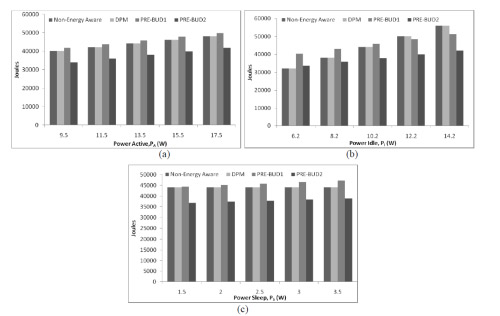
Total Energy consumption for various values of the following disk parameters: (a) power active, (b) power idle, and (c) power standby
The second set of experiments conducted focuses on the impact that varying disk power parameters has on the energy savings. We varied the power characteristics of our simulated IBM36Z15 disk. For each figure we only vary one disk energy parameter. The number of disks was fixed at four and the data size is 25MB. From the above figure we realize that lowering the Power Active, which is the energy consumed while the disk is in the active state, will decrease the energy consumption for all the strategies we compared. Lowering Power Active also impacts the relative energy savings that the PRE-BUD strategies are able to produce. If Power Active is 9.5W PRE-BUD2 saves 15.1 % energy over DPM. If it is increased to 17.5W PRE-BUD2 only saves 13% energy over DPM. Fig. 4 (a) is similar to Fig. 4 (b) but now we see that Power Idle has a greater impact on energy savings as compared to Power Active. If Power Idle, the energy consumed while the disk is idle, is very low PRE-BUD 2 has a negative impact, but if it’s increased to 14.2 W PRE-BUD 2 now saves 25 % of energy as compared to DPM. The last set of experiments varied the Power Sleep parameter, which represents the energy consumed while the disk is in the sleep state, also has significant impact on PRE-BUD strategies. The percentage change in energy savings starts at 16.3% and drops to 11.7% with increasing Power Sleep. The results illustrated in Fig. 4 indicate that parallel disks with low active power, high idle power, and low standby power can produce the best energy-savings benefit. This is because PRE-BUD allows disks to be spun down to the standby state during times they would be idle using DPM. The greater the discrepancy between idle and standby power, the more beneficial PRE-BUD becomes.
[Tjioe, Widjaja, Lee, and Xie, 2009] In a completely dynamic environment where a sub-set of files are extremely popular and receive a dominant percentage of user requests, a dynamic file assignment algorithm may no longer be helpful. The reason is that no matter where it places these hot files the load imbalance across the disks cannot be solved. In this situation, file replication techniques can be employed to make replicas for these popular files and to distribute them onto other disks. We developed a new dynamic file assignment strategy called DORA (dynamic round robin with replication), which integrates file replication techniques into file assignment schemes for a user access pattern changing environment. DORA first sorts all files according to file size. Next, it assigns the files to disks in a round-robin fashion so as to distribute the load of all files evenly across all disks. Finally, DORA dynamically keeps track of the load of all files and the load on each disk. For some extremely hot files, it then creates replicas to effectively distribute request accesses on these files across all disks in a disk array. Using extensive simulations, we evaluated the performance of DORA by comparing it with one of the best existing dynamic file assignment algorithms, C-V.
